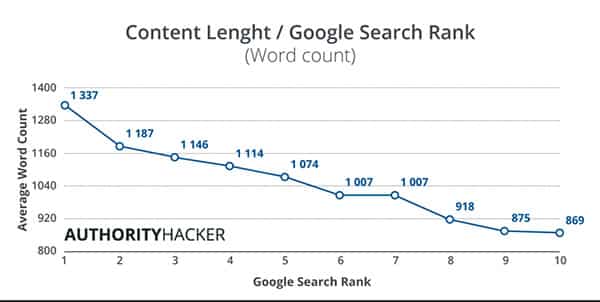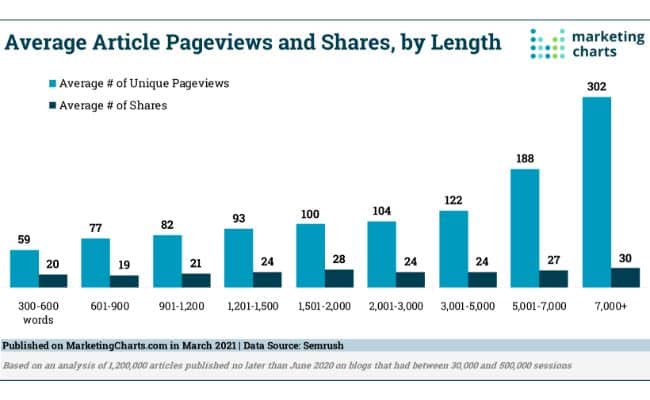The Internet is a sea of over a billion websites. 500 million of them are blogs and there are dozens of reputable blog hosting platforms that account for a large segment of the blogging industry.
As a result, blogs have become more accessible to visitors, creators, businesses, and organizations.
But simply writing and publishing a blog post does not guarantee you will reach the right audience.
In the context of content marketing, it is important for brands to understand the mechanisms behind every text and how Google sets the standards for high-ranking content.
The length of a blog post, for example, can decide the success or failure of the piece.
In general, long-form blog posts perform better on the SERP, but we must know when and how to write them.
So if you want to know the details on how long a blog post should be, don’t worry! We are about to cover all the following topics:
- Is There an Ideal Blog Post Length?
- The Optimal Blog Post Length Depends on These Factors
- Ideal Number of Words Per Type of Content
- 500-Word Blog Posts
- 1000-Word Blog Posts
- 2000-Word Blog Posts: The Benefits of Writing Long-Form Posts
- How to Determine Your Blog Post Length in 6 Steps
- Long-form Posts and SEO
- WriterAccess for High-Quality, Long-Form Content
Download this post by entering your email below
Is There an Ideal Blog Post Length?
Some content marketing experts suggest that 1500-2000 words are the ideal length of a blog post.
However, many companies and brands stick to shorter blog length guidelines (500-750 words) to honor a specific element of their marketing strategy.
Ultimately, the ideal blog post length depends on the characteristics of the persona, the user’s search intent, the purpose of the strategy, the type of content, and other elements.
It’s all about what is best for the user — in other words, what will better respond to your potential buyers’ questions when they first see your content?
If the answer can be written in 500 words, great. Do that.
But if you need a robust guide to cover all of the different aspects of a topic (a guide that will be more complete than what your competitors have on their sites), then you should invest in a lengthy text.
The Optimal Blog Post Length Depends on These Factors
Many factors can influence the quality and reach of a blog post. We’ve listed some of the most common influences on the length of a blog post:
1. Niche or industry that you are targeting
Some markets may require more explanatory texts, but others don’t.
2. Buyer persona
What type of content do they want to read? What they may be seeking at the level they are at professionally? Do they prefer shorter or longer texts?
3. Stage in the buyer’s journey
Some content is better than others for each stage of the buyer’s journey.
Shorter blog posts, for example, make more sense in the awareness stage, at the top of the funnel. On the other hand, longer blog posts can really work in the decision phase.
4. Search intent
The search intent of users involves a systematic approach to building content and a complete awareness of how consumers think and what invokes an action on their part.
Maybe their intention with a search is to read a 3000-word text; maybe they have a question that can be answered in a couple of paragraphs.
5. Keywords
Keywords can dictate the length of a blog post.
If you’re writing a text with the keyword “digital marketing”, it’s pretty much impossible to rank high with a short piece of content.
But if your keyword is something specific like “what is a URL sug”, then a 1000-word post is fine.
Ideal Number of Words Per Type of Content
A blog post is just one type of content. For all kinds of online material, from website content to social media posts, there are rough guidelines on how long the content should be. Here is a helpful guide to the ideal number of words for each type of material that you can use in your content creation planning:
- Press Release: A simple announcement that uses a standard template to communicate in a clean, simple way
- 400-700 words
- Update Articles: Short blog posts updating readers about a single issue, such as a policy change
- 400-600 words
- News Articles: Educational posts that update readers on things like industry news or new developments
- 600-1,000 words
- Use Cases: In-depth stories about the successes customers have achieved with the help of your business
- 500-1,500 words
- Informational Blogs: The best blogs for SEO, and typically what digital marketers think about when they discuss blogs
- 1,000-1,500 words
- Guides and How-Tos: Detailed handbooks that establish thought leadership and authority in specific areas
- 1,500-2,500 words
- Pillar Pages: Also known as 10x content, these are long-form pages that establish foundational content for your business
- 3,000+ words
500-Word Blog Posts
There is a high volume of 500-word blog posts across the internet because this is an effective marketing tool for emerging businesses and brands, and for brands that seek to offer answers to very specific questions.
This blog post length produces answers to more direct and simple questions, too (like “Is bold text good for SEO?”).
While 500-word blog posts have a lower search volume, they also face less competition, which can be valuable for brands.
Some companies use a 500-word blog post to highlight their brand’s history, mission, goals, and products and services.
Others may highlight very specific keywords or create a more localized SEO strategy.
A blog post of that length doesn’t need to reinvent the wheel, but it should serve as reinforcement for a brand and a creative way to communicate with its audience.
1000-Word Blog Posts
It’s important to be thorough, and this can’t always be accomplished in a 500-word blog.
The 1000-word blog post serves to answer questions that are simple, yet require a bit more detail (for example, “Big Data for freelancers: know the apps that can help you”).
With more in-depth and detailed writing, a blog length of 1000 words allows you to cite sources and delve into topics more comprehensively, supporting your content even more.
This kind of blog post allows for greater authority. Writers can dig deeper into research and thought leadership materials that support their purpose.
Often, keywords within a 1000-word blog post wouldn’t have worked with just 500 words.
Marketers and brands can utilize this length to offer technical content that’s been adapted to specific personas, too.
2000-Word Blog Posts: The Benefits of Writing Long-Form Posts
When your brand requires complete, in-depth, and detailed content, a 2000-word blog post is the ideal length.
This blog post length allows you to explore every aspect of the topic and to ensure you answer your visitors’ search intent.
When you look up on Google “how long should a blog post be for SEO”, generally, you’ll find that it’s the long-form blog posts that do best.
With so much content online, consumers are faced with an influx of information that claims to be reliable. Long-form content can help you beat your competitors and get listed higher in the SERPs.
But it’s also a way to show off your expertise and provide content that enables your readers to build trust in your company.
The very best content that is produced at this length should offer high value in the form of research, data, and analysis.
For example, “What is SEO?” is a topic with a high search volume and highly sought-after keywords.
This topic needs a long-form post to cover the topic in enough detail and to deliver quality, “well-keyworded” content that will rank higher in the SERPs.
Posts of this length may contain a guide or large lists, often with a linked menu for easy navigation and a better user experience.
Bear in mind that the reader doesn’t want to have to work too hard, especially given the length of the blog post.
If you want your readers to stick with you through the whole length of a long-form post, it’s vital that your content is first and foremost of the highest quality. Secondly, your content should be easy to read, with plenty of white space, bullet points, subheadings, and quality images to break it up.
But when should you write a long-form post of over 2000 words?
This type of blog post is often used at the bottom of the sales funnel.
At that point in the customer journey, your visitors are likely to be half-sold on your company and your products or services.
What they need now is more detailed content that gives them everything they need to know about how you can help.
This can then be the final push to get them to act, either by signing up for your mailing list, by booking a sales call or a demo, or even by buying.
These long-form posts are also excellent for SEO and can be a good way to get, and stay, ahead of your competition.
You can both write new content and also create upgrades to existing content to create better and more in-depth posts than your competitors.
2000-plus-word blog posts are ideal for this.
1) Increasing the time users spend on the page
One of the most important ranking factors for Google is what’s known as dwell time. Google tracks how long visitors stay on your site and consume your content. They use this as part of their decision-making process when deciding where to rank your content.
Naturally, 2000-word long-form articles will keep your customers reading your content for longer, but only if it’s quality content that answers their search queries and intent.
You can also add internal linking to your long-form articles to send visitors to other blog posts with more details on particular aspects of what they are searching for. Again, this is another way to keep your visitors reading and increase your dwell time.
2) Exploring content in depth
With only 350 words or 500 words, you really can’t fully explore any topic, particularly not anything that’s detail-oriented and involved.
With the “What is SEO?” topic we talked about earlier, you’d hardly have managed the introduction and part of your first explanation before you ran out of room.
When you want your visitors to keep reading, it’s important to be able to provide in-depth blog posts that explore all facets of your main topics on your website.
You can also write shorter posts that go into more depth about just one aspect of your topic.
Taking the example of our SEO article again, you could write a long-form 2000-word guide for your main blog post and then link out to another shorter blog post that goes into great detail about the subtopic of blog post titles.
While you don’t want to bore your readers, these long-form articles really do offer the chance to show how much you know, build trust with your readers, and grow your reputation.
3) Ranking higher on the SERPs
You shouldn’t write longer blog posts for it, and nor should you add fluff and padding to them just to lengthen them. To rank higher on the SERPs, you need top-quality blog posts that are well-researched, well-keyworded, and well-written.
Research your competitors’ posts and look at what they’ve done that’s better and also look at what they’ve missed that they should have included.
You’re now in a great position to either give an older post a content upgrade or write a new post that beats your competitors’ posts. Consistently creating excellent content will get you ranking higher in search engines.
How to Determine Your Blog Post Length in 6 Steps
If you are unsure of how to pick the right length for your blog post, you aren’t alone. There are many digital marketers and content creators who struggle to choose the right form of content and length for blog posts. Thankfully, these six helpful steps can guide you in the right direction when selecting blog post lengths.
1. Brainstorm Your Topic
To begin, you need to know what to write about. Decide what you want to cover and what information or research you will share with your readers. Once you know what the topic of the blog will be, you can move on.
2. Determine the Purpose of the Blog
When you examine the list of content types above, you can see that the kind of material you want to create will affect the ideal word count. Determining the purpose of your blog will help you get started with the right type of content.
3. Create an Outline
An outline of your blog can help you visualize the length. When you first brainstorm your topic, you might not be sure what sections or subheadings you want to include. An outline enables you to lay it out and put your ideas on paper.
4. Estimate Your Word Count
The next step is to estimate the word count for each portion of your outline. How many words do you think each paragraph or section will need to communicate the point? How many should you aim for?
5. Adjust for Short or Long-Form Guidelines
Once you’ve estimated a total word count, you can go back and adjust your sections to suit either short-form or long-form ideals. If you have too many sections, for example, you can remove some and use them in a different blog post.
6. Evaluate Your Content Plan
Take your new blog idea and put it in the context of your content plan. Is there a similar article you can combine to make a long-form post? Or could you update existing content to turn a short-form article into a long-form one? Having a solid strategic plan helps your content marketing come together.
Long-form Posts and SEO
Long-form posts and SEO go hand in hand. You can explore your topics in more detail to establish your authority, and the length of the posts allows you to include keywords and phrases that people are naturally searching for. However, it must keep the users’ attention and interest longer.
Here’s how to boost your SEO when writing long-form posts:
1. Use engaging headings
The first thing people see in search engine listings or on your own pages is the heading of your blog post.
Obviously, you need to have an engaging and intriguing post title to grab attention and make people click through to your post.
This is such a vital part of your post. It doesn’t matter how good it is if no one reads it.
Pay attention to your headings, make them engaging, and ensure they tell your readers why they need to read your post.
In addition, include your main keyword in your title as near to the beginning as you can to help with SEO.
It’s also important to use great headings and subheadings throughout your posts. Headings break up the text so that it’s easier on the eye. However, another important job for headings is to create “scanability”.
Think carefully about each heading and make sure it follows logically from the previous heading and draws the reader down the page.
Most readers don’t read every word of your blog posts. They scan them. With great headings, you allow readers to scan down your post and quickly see what it’s about. They will then read it in more detail as long as your content captures their attention.
2. Write a great introduction and conclusion
In order to keep your reader on the page, you need an attention-getting introduction that tells them what your post is about and why they should keep reading.
For SEO purposes, it’s equally important that you include your main keyword in the upper part of your introduction, preferably in the first paragraph.
Your conclusion should wrap up your post perfectly, summing up the content well and providing a satisfying end to your post.
However, it’s also a great place for a call to action to get your readers to either read more or take the next action you want them to take.
3. Create great visuals
Readers won’t stick around to read a huge wall of text, however good it is. You need to break it up. You can do that with headings and bullet points, and allow for plenty of white space, but your visual elements are an important part of how good your post looks on the page.
Use relevant, high-quality images and link to relevant videos to back up what you’re saying. Most people love to watch a good video and will enjoy the chance to get more information on the subject.
You could also create your own well-branded graphics, using Canva or similar software, or even create infographics to illustrate your posts.
4. SEO and UX work hand in hand
Google is increasingly looking at user experience when considering where to rank content. This is something that you can no longer afford to ignore.
We’ve talked above about breaking up the text for ease of reading and using headlines to draw the reader down the page. These are part of an excellent user experience.
You can also add a clickable table of contents at the top of your post to help readers skip to particular sections and find what they want more easily. This also tells the reader what’s in the post and what to expect.
Another trick to make for ease of reading and add to a good reader experience is to use bold text to highlight important points in your post.
Consider how your visitor will feel when visiting your site and look at what you can add, and sometimes more importantly, what doesn’t need to be there for the optimum user experience.
5. Writer Access for high-quality long-form content
In order to have quality blog posts of any length on your website, you either need to become a content creator yourself, or bring in the professionals to add all the benefits of quality digital content creation, without it taking up all your time.
At Rock Content, we have the ideal solution for when you want to invest in high-quality long-form posts, without the effort.
Writer access can help you find the best writers to create high-quality long-form posts and scale your content production. You can get a 14-day Writer access trial to see how it works.
Pros and Cons of Long-Form Content for SEO
There are some major pros and significant cons of long-form content and SEO that you need to keep in mind as you develop your content plans.
Long-form content tends to perform better in search results. The reason for this has to do with the Google algorithm. When someone asks a question or types a query into Google, the algorithm wants to provide the best, highest-quality listings for searchers.
The longer the content is, the higher the chance that Google will identify it as helpful to users.
Long-form content also has more opportunities to gain backlinks, which enhances SEO rankings. The more high-quality links point to your content, the more Google’s search algorithm will trust it.
If you create a short 600-word article, it’s not as likely that other reputable websites will want to link to it.
Another benefit of long-form content is its shareability. Longer content tends to get more shares because it provides greater detail and context than short-form articles. That makes it more valuable to people who want to help educate their own networks.
However, there are some distinct disadvantages to long-form content as well.
The first is that it takes much longer to create, produce, and distribute. Short articles can be written far more quickly, and they will cost less money if you outsource content creation.
A long-form piece of content takes more planning and time, which can be problematic for small teams.
Another potential disadvantage of long-form content is that it’s not always mobile-friendly. Someone with a mobile device can quickly scroll through a short article.
Long-form content, on the other hand, tends to have larger paragraphs and less white space along with fewer headers and page breaks. That can make it difficult to navigate on a smartphone.
WriterAccess for High-Quality, Long-Form Content
While the concept of blogs can seem simple, it is crucial to dedicate time and resources to understanding how successful blogs maintain their rankings. If you’ve previously succeeded with a specific blog post length, consider this for future publications.
But, don’t be intimidated by experimenting, especially as you build your domain authority and content library.
Having the right content creation partner is essential to the success of your content marketing initiatives. That’s where a platform like WriterAccess comes in handy.
WriterAccess is more than just a platform connecting businesses to freelance writers. It also provides skilled strategists and content experts who can offer guidance when it comes to picking the right content length.
Our writers can help you go through the steps of determining blog length and recommend the best approach. This allows businesses like yours to avoid the stress of trying to figure out an exact word count. Instead, our team of vetted experts will complete the strategic planning for you.














